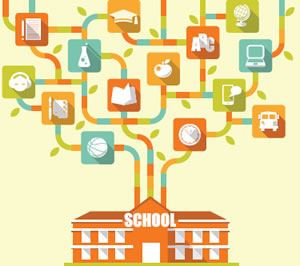Advanced UC Phone Systems
- By Cameron Moredock
- 10/01/14

IMAGE © ISTOCKPHOTO / FILO
For more than 85 years, The Carey School has educated hundreds of children in San Mateo, Calif. The school, with classes for pre-kindergarten through the fifth grade, is home to 300-plus curious, confident and joyful learners, teachers and staff in a strong independent school. Along with traditional academics, the school offers a broad range of before- and after-school enrichment programs.
Over the years, the multi-building facility has gone through various upgrades, including the last one in 2007 when several buildings were replaced. In 2013, the school began its largest construction project since opening in 1928, upgrading parts of the school that had not been touched for more than 50 years. The area of new construction will account for 50 percent of the school’s total square footage once completed.
With an emphasis on upgrading the campus, the decision was made to expand the effort to replace its outdated phone system with an advanced communications solution. The quality of technology available to administrators, teachers and IT staffs has improved exponentially in recent years. Advancements have been realized in learning materials, management systems, software solutions and the hardware that students use (including laptops and tablets). The increased availability of Internet-based learning applications has even further revolutionized the way students are educated. The communications system is one key technology that’s a staple of schools that has rapidly advanced with valuable benefits for education. A reliable communications system is critical to any organization, but the ability for a school to connect administrators, teachers and parents is particularly important, especially as it relates to the safety of the students.
Challenges
The school faced many challenges as the multi-phased construction project got underway. With a large portion of the school under construction, many students were relocated to portable trailers, including those in the second and third grades as well as students in the foreign language and music classes. This created a significant communication issue since the existing phone system would not be available in the trailers. The Carey School needed a phone system that performed well in the trailers and between the existing buildings across campus. The school also wanted a feature-rich, futureproof system that could be used well beyond the completion of the construction project. Before breaking ground, The Carey School was using an old proprietary system, a legacy system with unique programming components that were obtuse and not friendly. Anytime there were “adds, moves or changes” to be made for staff members, or even with the simplest of changes, an expensive outside vendor who was trained in that phone system had to be called in. In fact, it was so expensive to have the third-party work done that the school waited for several before calling in the technician. That way the school could maximize the work being done during the site visit to help better manage costs. But the delay in service also meant that critical changes just had to wait. This process of waiting and grouping phone changes could take weeks. In addition to being a hassle, it was simply inefficient.
Having suffered through the expense of maintaining an outdated system, the school knew the complete cost of a new system would have to be a serious consideration in the evaluation process. The school needed a system that was not only more cost-friendly, but also easier to deploy and administer than its old system.

IMAGE © SHUTTERSTOCK / EVELLEAN
Talk To Me. Schools with multi-building facilities or those going through multi-phased construction projects can face communications challenges. One way to address these challenges is to replace the likely outdated phone system with an advanced communications solution. A Unified Communications (UC) business phone system can offer robust and easy-to-use features such as sophisticated call routing and mobile applications, allowing everyone the possibility of being connected.
Solution
After extensive research, The Carey School selected Digium’s Switchvox Unified Communications (UC) business phone system. The school concluded that a UC system would be a smart choice due to lower anticipated costs, and would offer robust and easy-to-use features such as sophisticated call routing and mobile applications.
Without having a technical support team onsite, the school wanted to find a certified partner that could help with the implementation of the UC phone system. It wanted one that was located nearby in order to help with the entire project from planning to deployment of the new system. Its research led them to TeleDynamic, a long-standing Digium partner located in the area with a strong track record working with companies to overhaul or replace existing phone systems. It was a relief to know that if a problem or issue were to arise, someone could be onsite to review and resolve any issues — things that inevitably come up during projects of this size.
In preparation for the deployment, the company handled technical programming and preconfigured the IP phones. The school and a local contractor wired the classrooms and the portable trailers with standard category-5 cabling and Ethernet switches. Phones were then connected and mounted on the walls, and the phone system just worked.
Results
Going into the deployment, the ideal indicator for success of the phone system upgrade project would be to roll out the new system and hear nothing from the administrators, teachers and other staff. And that is just what happened. The positive results were numerous and the features and benefits of the new system have already been enjoyed, including:
- For the first time, staff can receive email notifications when they have a new voicemail.
- Through custom scripts, the phones can be used as the school’s bell system.
- Calls made remotely appear as though they are coming from the staff’s school extension so personal phone numbers need not be given out.
- Teachers can now set “do not disturb” rules for their classroom.
- Presence, or awareness, is now viewable from the main switchboard.
- All phones operate similarly so there is no learning curve.
Changes to the phone system – such as adding new users and moving phones from one location to another – now take minutes, versus days or weeks. Plus, the changes can be handled in-house without having the high maintenance costs of paying a vendor to do the work.
The Carey School has been able to reduce its costs significantly with perpetual licensing. Other vendors had licenses that expired every year or once every three years, which would have been an ongoing expenditure for the school. The Carey School now knows its fixed telco costs for the year, rather than unpredictable month-to-month costs with its old system. This has helped the school with budgeting.
This article originally appeared in the issue of .